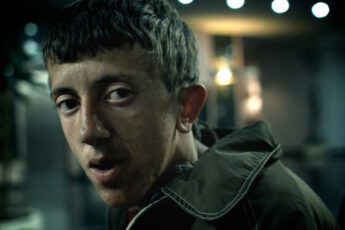A Gray and Uncertain View of the Russian-Ukrainian Conflict
Dmytro Moiseiev’s Grey Bees (Siri bdzholy, 2024)
Vol. 143 (March 2024) by Antonis Lagarias
Other than countless casualties, war also brings the massive displacement of people who, to save their lives, flee soon-to-be war zones. The forced abandonment of one’s home comes with questions about identity. Being a stranger, (not) belonging and longing to return are emotions that shape the lives of people in forced exile. Cinema has extensively looked to displaced persons, and many filmmakers, often themselves in exile, use cinematic means to explore and understand their own condition through personal and poetic films. At the same time, the desire to remain at home is considered almost sacred and universal, meaning that it rarely needs rational justification. This is all the more common in the case of the elderly who, without the energy or desire to “start anew”, may “stubbornly” refuse to abandon the last traces of familiarity that sustain their daily lives, and remain in their homes even if this may mean their death. In this, cinema can assume a strongly politicized dimension, conveying to outsiders a complex yet clear glimpse of what it means to choose between being uprooted (becoming a stranger among strangers) and death. It can reveal the complexity of this impossible choice that so many people have faced in recent years (in Syria, Afghanistan, Ukraine, or Palestine, to name but a few cases), and act against nationalist or xenophobic narratives.
These questions inevitably come into play in Dmytro Moiseiev’s Grey Bees, the latest in a series of Ukrainian films that look not only at the Russian invasion of 2022, but also at the lasting consequences of the events that followed the 2014 Maidan Revolution, in particular the Russian annexation of Crimea and the early instances of armed conflict in Eastern Ukraine. The story takes place in the Ukrainian region of Donbas a few days before Russia’s full-scale invasion in February 2022. It follows the daily lives of the last two residents of a now almost abandoned village located in the “gray zone”, an area that stands between those controlled by Ukrainian and pro-Russian forces respectively and that is now being turned into a “neutral” (war)zone. The film opens with the sounds of explosions that threaten to shutter the few remaining glass windows of the village. The people have long fled, with the exception of beekeeper Sergiich and his neighbor Pashka, both in their sixties. Sergiich is serious, laconic, and seems to adhere strictly to personal moral principles. Pashka appears as his polar opposite, free-spirited and indifferent to morals, stealing without hesitation anything useful from the empty houses, including food supplies, tools, windows, and even nude photos of the former owners. The two men are further separated by their political stance, with Sergiich being seemingly hostile to the pro-Russian side, while Pashka appears open to all, especially when it comes to a quick drink with the separatist forces.
Despite their differences and constant arguments, the two men are shown to have developed genuine friendship and mutual understanding, sharing the peculiar condition of having witnessed the destruction of their familiar landscape and its transformation to a strange place between the frontlines. Trapped there, they stand united in their loss and solitude, overcoming their ideological differences. Eventually, their forced coexistence makes them care for each other. Cut-off from the rest of the world, visiting each other and exchanging their scarce provisions thus becomes a daily habit. The slow pace of the editing and the long uncut shots emphasize this feeling of stagnation, while the camera focuses on destroyed houses or on landscapes full of debris. Yet the two men somehow maintain a sense of community, remembering the village residents who have left and those who have died. The film’s most memorable scene shows the two men collecting letters addressed to the dead or missing that occasionally arrive with the post and reminiscing about the village’s past and the stories of those no longer here.
The relationship between Sergiich and Pashka serves as a paradigm that contrasts with the ongoing conflict. It depicts a kind of human connection and solidarity that overcomes all personal differences, born of sharing a land and experiencing mutual suffering. Based on Andrey Kurkov’s novel of the same name, the ideology and arguments of the film appear in the form of dialogue. Sergiich spends hours discussing with a Ukrainian soldier, whose nightly visits, on the pretext of bringing food, allow him to check on the possible Russian infiltration of the village. Their conversations address the film’s central question: why Sergiich (and Pashka) choose to remain in a decaying gray zone where food is scarce and their lives are under constant threat. Sergiich’s response confirms his desire to remain at a place he calls home, but also hints to a general disappointment and disillusionment about his place in the world, alluding to a gradual financial decline of the region, the loss of jobs (the closure of a local mine is mentioned as an example), and the indifference of the central government. Sergiich seems to extend responsibility for the current situation to the pre-2014 period, drawing a link between the economic reality of a forgotten region and the separatist political narrative. Indeed, the film suggests that the financial precariousness associated with social exclusion becomes fertile ground for Russian influence, which comes with promises of independence and self-determination. Having only distant relatives, Sergiich is also conscious of his loneliness, and he rejects the idea of leaving his familiar village only to find himself in an unknown place surrounded by strangers. This bleak portrait of a collapsing society adds a somewhat new dimension to the ongoing conflict in the Donbas. While both fiction films and documentaries (such as Maryna Er Gorbach’s Klondike, Simon Lereng Wilmont’s A House Made of Splinters, and Signs of War by Juri Rechinsky and war photographer Pierre Crom) remind international audiences that the region was already in conflict before the full-scale invasion, the pre-2014 period is mostly overlooked. In these matters, Sergiich often sides with Pashka, justifying his friend’s actions (notably his friendship with pro-Russian forces) and suggesting that for people like them, there was never really any choice, their financial survival always being at stake. In this, the film seems, for a brief moment, to oppose any grand ideological narrative and instead addresses the consequences of accumulating financial and social issues, showing how they can also serve as a basis of uniting and understanding each other among the neglected.
This engaging take on the conflict is however soon abandoned in favor of a more common national narrative. The film gradually leaves behind the relationship between Sergiich and Pashka to focus exclusively on the moral choices of the former. The viewer is expected to recognize Sergiich’s superior ideological principles in his insistence on burying the dead or in his refusal to accept supplies from the Russian side even when he has no food left. Apart from this, little effort is made to convey his inner thoughts or to explain the origins of his personal principles, which remain obscure for the most part. Also, his critical stance on the choices forced upon him by the government and people outside the region proclaiming their patriotism, eventually becomes irrelevant for the film’s narrative. While he initially asserts that in harsh conditions (from poverty to war) people are often faced with difficult, even impossible choices, and the “right” action is never obvious, he later admits his own responsibility for some of the social issues that devastated the region (by saying for instance that he could have acted against the closure of the mining operation, but simply “chose” not to). By the end of the film, Sergiich’s distancing from the world appears mostly as a consequence of personal weaknesses and failures. The film thus shifts the responsibility from the social to the individual, and, having nothing left to lose (one scene suggests that his remaining family has suffered some kind of tragedy), Sergiich abandons his neutrality and decides to take action, just as the Russian invasion is imminent.
One might wonder about the reasons behind what feels like a surprising reversal of some of the film’s established narrative themes. Perhaps it is an attempt to “update” certain plot points from the novel (published back in 2018) in the light of the tragic events of 2022. However, by negating its ambiguity, the film also misses a point. A nuanced and personal narrative is needed if one is to explore what it really means to have nowhere to go and to choose to remain in limbo where life has stopped and death is imminent. It is clear that the conflict in the Donbas is complex, a result of political actions spanning several decades. To address and better understand the situation, it is important to look beyond black-and-white moral statements, easily linked to wider political narratives, and explore the gray areas as well, as the film’s title promises but never quite delivers.




Leave a Comment